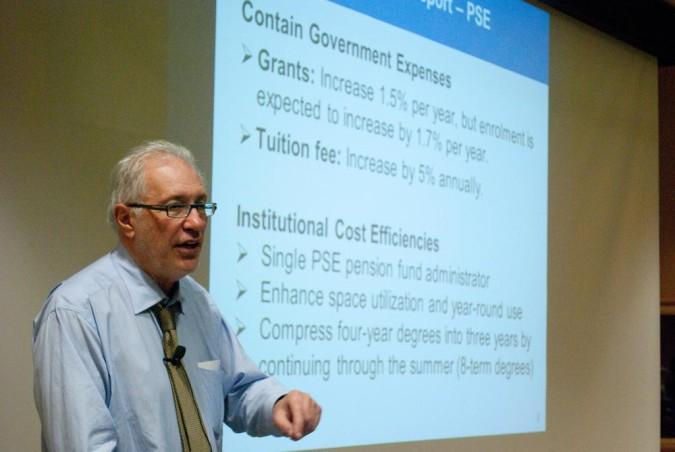President Sheldon Levy’s town hall predicted a 5 per cent rise in tuition fees, and shortly after the cap was confirmed by the provincial government. Susana Gómez Báez reports
The Ontario government is extending the 5 per cent tuition cap for another year. As a result, the 2012-13 tuition fees cannot go up more than that cap.
This is a relief for many students as it delays any drastic surge in tuition fees for at least one more year.
In a community town hall meeting on March 7, Levy anticipated a three to 5 per cent budget cut that could result in tuition fees rising 5 per cent for next year.
“It’s not a surprise and we are prepared for it,” he said.
In his presentation, Levy talked about the growing $17 billion provincial debt and slow economic growth as reasons for the university’s need for money. He announced that Ryerson would make sure to have enough funds for students in financial need, addressing concerned students and faculty members.
As further financial aid, the government is applying the 30 per cent tuition rebate for the entire year, granting university students and college students $1,600 and $730 who fit the requirements.
There was speculation of a plan for 2012-13 by the Ontario government that would place a temporary suspension on establishing a flat fee — a set tuition fee that applies to every university — for arts and sciences programs.
According to an article in the Toronto Star, the supposed flat fee under consideration was pegged at $5,366. Although the estimated figure is only $75 less than what Ryerson arts and sciences students paid this year, it would cost Toronto-area universities millions of dollars.
In a later article, the Star reported that it had only been an idea that was passed around university presidents and Glen Murray, the Minister of Training, Colleges and Universities denied the standardization of tuition fees.
Murray said that despite the fact that the government was working on making post-secondary education more affordable, creating a flat fee was not one of the suggestions.
The proposal of everybody paying the same tuition, seemed appealing to Ian Sakinofsky, a Ryerson business professor.
“I think it’s a good idea because universities shouldn’t be using fees to manipulate public education,” said Sakinofsky. “Fees shouldn’t determine where people go. It should be the same everywhere.”
The government’s current framework has been in place since 2006. Since then, tuition in Ontario has risen by $1,480, according to Statistics Canada.
“[The annual increase] is putting the burden on the students instead of putting the burden on the government,” said Sakinofsky.
The province receives the lowest government funding in the country to go with its nation-leading tuition fees, according to the Ontario Confederation of University Faculty Association.
This year, Statistics Canada calculated that the average tuition in Ontario was $6,640, and represented a 5.1 per cent increase compared to last year. The next highest fees are in New Brunswick, but they are almost $800 less than in Ontario.
“Instead of raising tuition by 5 per cent and giving students back $1,600, why don’t they keep that money and lower tuition a little bit for everyone?” said Sakinofsky. “Tuition keeps going up but funding doesn’t go up as much.”










1 Pingback